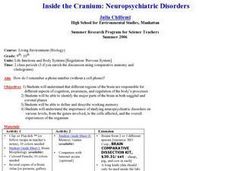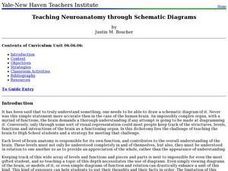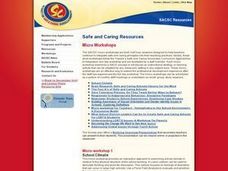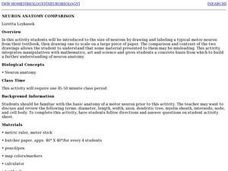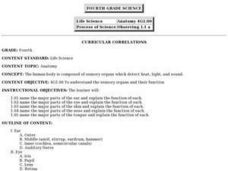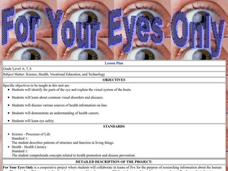Curated OER
Review for Strand 2A Test: Nervous System
Three pages containing 51 true and false questions make up this nervous system review. The major topics listed at the top of the test mention a film strip and a laboratory activity, but the questions appear to be answerable without...
Curated OER
Anatomy
Third graders explore the basic structures and functions of the human body and how they relate to personal health.
Curated OER
A Black Box Problem: How Do I Hear?
Students assemble a diagram of the hearing pathway using information about its parts and their function, and predict the changes in hearing that might result from specific changes to the pathway.
Curated OER
The Senses
In this senses worksheet, high schoolers use a text book to complete 34 fill in the blank statements about the structures and functions associated with the 5 senses.
University of Minnesota
What's the Deal? Addiction Card Game
Addiction is a big deal! Playing a game of cards helps learners understand the concept of addiction. Through their analysis, they examine the potential for addiction and how it varies for each individual.
K12 Reader
Tissues, Organs and Systems
Young scientists are introduced to the connections among cells, tissues, organs, and systems in a life science reading comprehension worksheet that asks them to respond to a series of questions based on the passage.
Curated OER
Inside the Cranium: Neuropsychiatric Disorders
Young scholars analyze different regions of the brain which are responsible for different aspects of cognition, awareness and regulating the body's process.
Curated OER
Teaching Neuroanatomy through Schematic Diagrams
Students identify the parts and function of a neuron. They explain and illustrate the levels and functions of the nervous system including neurons and the Central and Peripheral Nervous Systems. They analyze and diagram the Lobes and...
Curated OER
Edible DNA
Students use multicolored soft candies (gumdrops and candy orange slices) and toothpicks to create models of DNA structures. They discuss the fact that DNA must copy itself before splitting into two cells. Students demonstrate this by...
Curated OER
Oh, Say Can You See
Students explore different parts of the eye and functions of each part through a video and a dissection of a cow's eye. They discover different causes of blindness.
Curated OER
Special Senses
In this special senses worksheet, 9th graders briefly describe the structure of a taste bud and the pathway a signal takes to the brain. Then they list the five basic taste sensations and homeostatic values of taste. Students also...
Curated OER
The Real Bionic Man
Students examine the work that scientists have been doing to create artificial human parts. In this exploratory lesson students research the human eye and brain using the Internet.
Curated OER
School Climate
Students examine school climate in relation to the physical structure of the school building. A Luann cartoon can be used to stimulate thinking and promote discussion which focuses on feelings of alienation that can occur in large high...
Curated OER
Apoptosis: Programmed Cell Death During Development
Students model the plasticity of neural pathways for memory in the brain. They simulate the cell activity according to dots on cards that they are given. They complete various simulations of different cell combinations.
Curated OER
Neuron Anatomy Comparison
Pupils create a scale model of a motor neuron that is two hundred times larger than the actual neuron. They identify the structures of a neuron and observe neurons under the microscope then use a worksheet to convert actual sizes into...
Curated OER
Anatomy
Second graders identify the major organs of the body and their primary function, identify major systems of the body, and describe behaviors that protect the body structure and organs.
Curated OER
Anatomy
Fifth graders identify and describe the functions of the major body systems. They discover how to maintain a healthy lifestyle with proper nutrition and exercise. They answer comprehension questions to end the lesson.
Curated OER
Anatomy
Fourth graders describe how health behaviors affect body systems, and describe the basic function of major body systems.
Curated OER
Cells Vocabulary List and Definitions
In this cells worksheet, students learn the important vocabulary pertaining to cell biology. Students read 14 words with their definitions. There are no questions to answer.
LABScI
Vision Lab: The Eye
Our bodies have some amazing capabilities, but there are some limitations. Explore the limitations of the human eye through the eighth lab activity in a series of 12 biology lessons. Individuals measure their own peripheral vision...
Curated OER
For Your Eyes Only
Students complete several activities in a unit related to the eye. In this eye lesson, students work in groups to research information about the human eye and create a multimedia presentation. They research anatomy of the eye, how the...
Curated OER
Rhythm and Art: Gesture Drawing
High schoolers explore connections between non-verbal language and art. In this visual and auditory art lesson, students investigate the science of sound and principles of drawing. They then use various genres of music to directly apply...
Curated OER
Neuron Cookie
Find out just how enticing learning about neurons can be by creating models with sugar cookies, icing, and candy. With great background information for you and an easy procedure for the kids, studying cells has never been more fun or...
Serendip
How Do We Sense the Flavors of Food?
We taste with our taste buds, so why do flavors change when we have a stuffy nose? Scholars experiment with taste testing while holding their noses and then while smelling. They record their observations in pairs and come together to...








